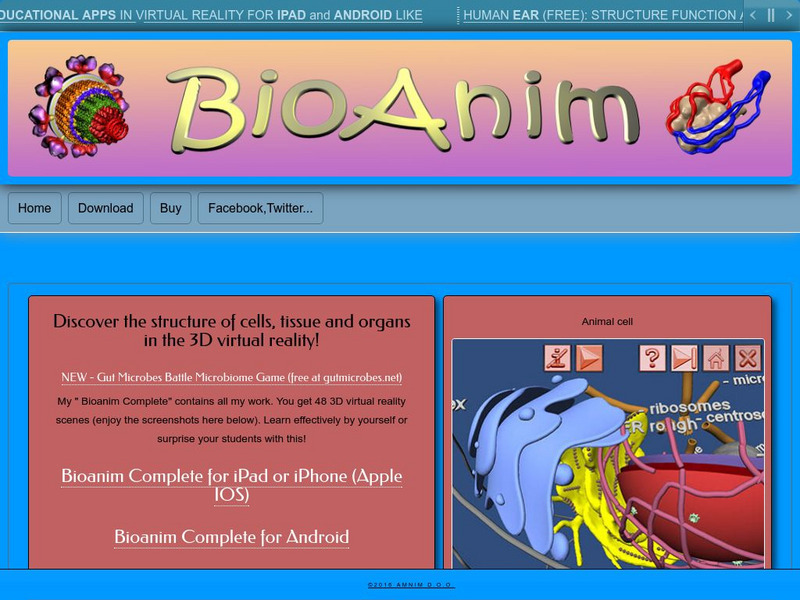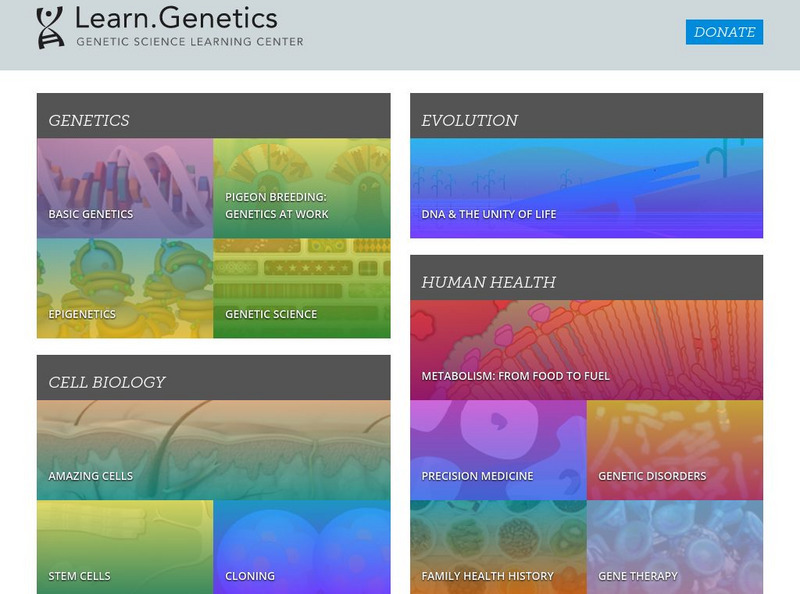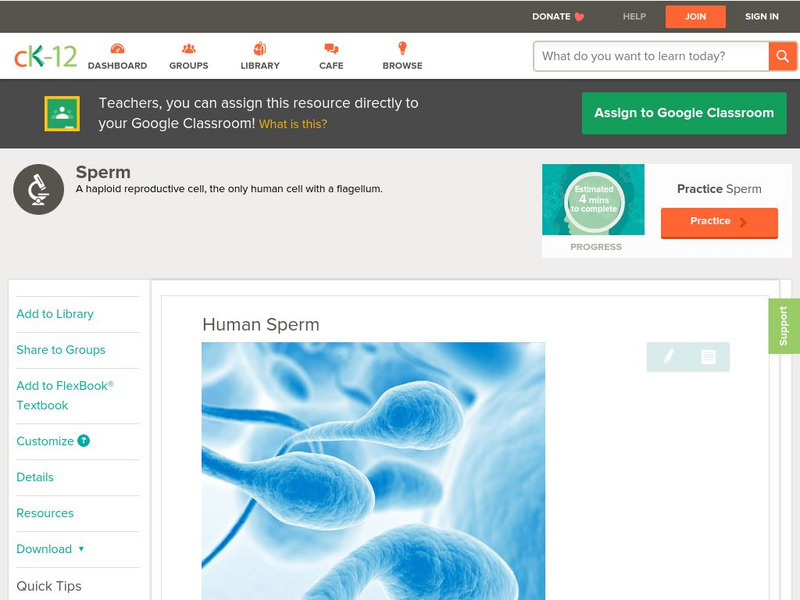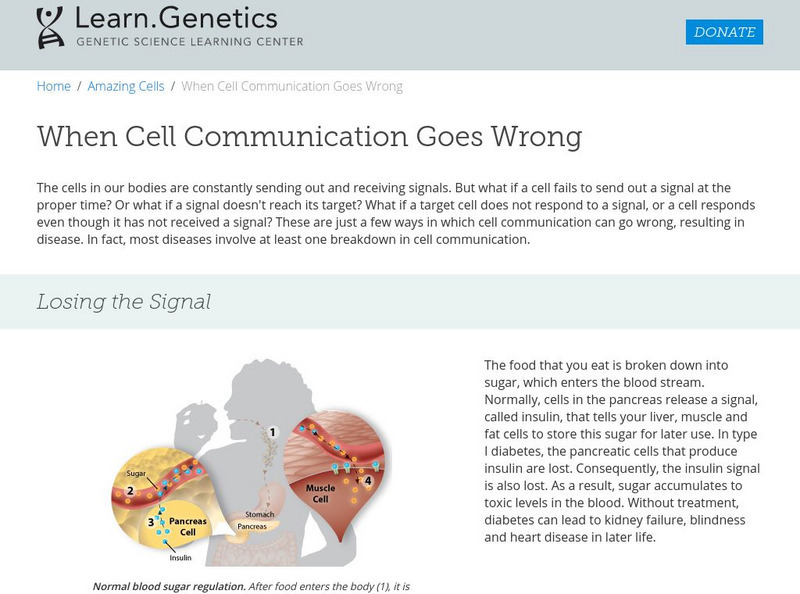National Institutes of Health
National Institute of General Medical Sciences: Inside the Cell
Very good science e-book that details why cells are the fundamental unit of life and why our health depends on what happens within the many different cells that make up our body. Each chapter is presented separately and the book can also...
Other
Bio Anim
BioAnin presents 3-D labeled images of all of the major systems of the human body, for example, the digestive system and the endocrine system. The images are embedded in slideshows. The site also has interactive 3-D models that can be...
CK-12 Foundation
Ck 12: Organization of the Human Body
[Free Registration/Login may be required to access all resource tools.] A variety of learning opportunuties about levels of organization in the human body. Includes videos, activities, discussion questions, and quizzes.
Earth Life
Earthlife: Cells
Thorough introduction to cells and their importance to life. Includes various types of cells and their function. Good diagrams of the different types of cells.
CK-12 Foundation
Ck 12: Episd: Organization of the Human Body
[Free Registration/Login may be required to access all resource tools.] From basic cells to tissue to organ systems, identify and understand the structures and functions of the human body's organization.
Cells Alive
Cells Alive!: How Big Is A
"Use this animation to compare the relative sizes of cells and organisms sitting on a pinhead. See the size of these nearly invisible without magnification" View dust mites dwarf pollen grains and human cells. In turn, bacteria and...
TeachEngineering
Teach Engineering: Cells
In this unit, students look at the components of cells and their functions and discover the controversy behind stem cell research. The first lesson focuses on the difference between prokaryotic and eukaryotic cells. In the second lesson,...
Cells Alive
Cells Alive!
Animation studio that specializes in medical illustration lets you explore the structure and function of plant cells and animal cells, using videos and interactive graphics with clickable parts that lead to more detail.
Massachusetts Institute of Technology
Mit: Open Course Ware: Courses: Biology: Introductory Biology
College-level introductory biology course focusing on the application of the fundamental principles of human biology. Course topics include genetics, cell biology, molecular biology, disease (infectious agents, inherited diseases and...
My Science Site
My Science Site: Cell Center Activities [Pdf]
Site provides six possible center activities for teachers to use to engage learners in the study of cells.
OpenStax
Open Stax: Structural Organization of the Human Body
Try considering the structures of the body in terms of fundamental levels of organization that increase in complexity: subatomic particles, atoms, molecules, organelles, cells, tissues, organs, organ systems, organisms and biosphere....
Untamed Science
Untamed Science: Biology: Human Biology: Blood
Learn about the structure and function of human blood as well as the composition of this complex substance in the human body through a series of video clips.
Curated OER
Eastern Kentucky University: Human Physiology: Cell Structure: Illustration
Labeled illustration showing the parts of a cell.
E-learning for Kids
E Learning for Kids: Science: Antarctica Research Center: What Do Cells Do?
For this lesson, students learn about the specialization of cells to perform different functions, and how they are organized into tissues and organs in the human body.
Palomar Community College District
Palomar College: Blood Components (Tutorial)
This review of what makes up human blood is easy to read and understand. There are guides to pronunciation and glossary links as well as a self quiz to check your understanding.
Exploratorium
Exploratorium: Microscope Imaging Station: Mouse Embryonic Stem Cells
Stem cells have an enormous impact on the structure of a living creature. This site features still images as well as short videos of these cells in action.
PBS
Pbs Teachers: Changing Your Mind: Nerve Cell Infomercials
Build nerve cell models in cooperative groups, and articulate the structure and function of nerve cells to explore the nervous system. Describe specific elements of human physiology by "advertising" the nervous system in nerve cell...
University of Utah
University of Utah: Genetic Science Learning Center: The Basics and Beyond
This website offers a clear definition of the science of Genetics, highlighting DNA and genes. There is a neat, easy-to-understand animated tour of the basics and an opportunity to go inside an animated cell. Student can build a DNA...
Exploratorium
Exploratorium: Microscope Imaging Station: Cell Motility
This interesting site explains how cells move and provides videos depicting the movement of various human and animal cells.
CK-12 Foundation
Ck 12: Life Science: Human Egg Cells
[Free Registration/Login may be required to access all resource tools.] When a baby girl is born, her ovaries contain all of the eggs they will ever produce. But these eggs are not fully developed. They develop only after she starts...
BiologyWise
Biology Wise: Endothelial Cells and Epithelial Cells
Discusses the differences between endothelial and epithelial cells, including where they are found in the human body, their function, and their structure.
CK-12 Foundation
Ck 12: Life Science: Human Sperm
[Free Registration/Login may be required to access all resource tools.] Sperm, the male reproductive cells, are tiny. In fact, they are the smallest cells in the human body. Some people think that they look like tadpoles. Learn more...
University of Utah
University of Utah: Learning Center: learn.genetics: Wrong Cell Communication
Learn about the many ways cell communication can be disrupted, and how this problem sometimes results in disease.
Cosmo Learning
Cosmo Learning: Introductory Biology
A collection of video lectures discussing applications of human biology taught at Massachusetts Institute of Technology. Lectures vary in length and cover topics like the cell cycle, stem cells, and cancer.

















